Scientist of the Day - William Crabtree and Jeremiah Horrocks
On Dec. 4, 1639 (Nov. 24 Old Style), the planet Venus passed across the face of the sun, in a rare event called a "transit of Venus." Only two people on the face of the earth observed the transit of 1639. One was a precocious 20-year-old named Jeremiah Horrocks, who watched from the hamlet of Much Hoole, Lancashire. The other was his good friend, William Crabtree, somewhat older in age at 29, who observed from his cottage in Salford, near Manchester, some 30 miles away. Crabtree was a middle-class merchant, a draper, with no university education, but with a keen interest in telescopic astronomy and with the means to pursue it. He first met the young Horrocks around 1636, when Jeremiah had just dropped out of Cambridge, where he had embraced the astronomy of Johannes Kepler. Kepler had noted that there would be a transit of Venus in 1631 that was unobservable in Europe, because it occurred when the sun was below the horizon. But Kepler did not realize that transits of Venus come in pairs, about 8 years apart (and then no more for another century), so that the transit of 1631 would be followed by another in 1639. It was Horrocks who figured that out from Kepler’s own data, but he didn’t do this until late October, 1639, too late to alert anyone but his friend Crabtree. So the two watched from their respective attic windows, projecting the sun’s image onto sheets of paper with their telescopes, late in the afternoon on that Dec. 4, and the clouds lifted just in time for both men to record the tiny black dot of Venus as it crossed the solar disc, the first ever to see such a sight.
Horrocks wrote a treatise, Venus in sole visa, that described his and Crabtree’s observations. But Horrocks’ early death in 1641 forestalled its publication, which was further hindered by Crabtree’s own death in 1644--they were only 22 and 33 years old, respectively, when they died. Venus in sole visa was not published until 1662, when Johannes Hevelius attached it to his own Mercurius in sole visa (fourth image above). This work, in the History of Science Collection at the Library, also contains an engraving of Horrock’s observations of the transit, but it was done by Hevelius, not Horrocks (fifth image above).
There is a plaque commemorating Crabtree’s observation of the transit of Venus at the site of his cottage in Salford (second image above). You can view a mural of Crabtree in the Manchester Town Hall, painted in the 1880s by the pre-Raphaelite Ford Maddox Brown, that attempted to recreate (none too accurately) the scene in Crabtree’s attic when the transit occurred (see first image above). And there is also an 1891 painting by Eyre Crowe in the Walker Art Gallery in Liverpool that imagines Horrocks’ observation of the transit (third image above).
Dr. William B. Ashworth, Jr., Consultant for the History of Science, Linda Hall Library and Associate Professor, Department of History, University of Missouri-Kansas City











